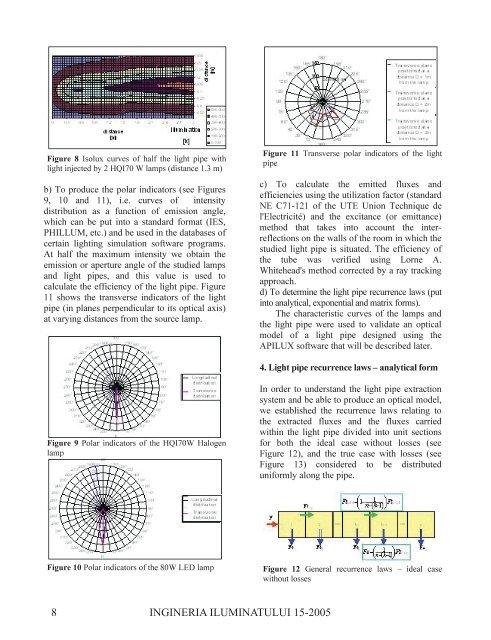Ingineria Iluminatului - Journal of Lighting Engineering - Prof. Florin ...
Ingineria Iluminatului - Journal of Lighting Engineering - Prof. Florin ...
Ingineria Iluminatului - Journal of Lighting Engineering - Prof. Florin ...
You also want an ePaper? Increase the reach of your titles
YUMPU automatically turns print PDFs into web optimized ePapers that Google loves.
Figure 8 Isolux curves <strong>of</strong> half the light pipe with<br />
light injected by 2 HQI70 W lamps (distance 1.3 m)<br />
b) To produce the polar indicators (see Figures<br />
9, 10 and 11), i.e. curves <strong>of</strong> intensity<br />
distribution as a function <strong>of</strong> emission angle,<br />
which can be put into a standard format (IES,<br />
PHILLUM, etc.) and be used in the databases <strong>of</strong><br />
certain lighting simulation s<strong>of</strong>tware programs.<br />
At half the maximum intensity we obtain the<br />
emission or aperture angle <strong>of</strong> the studied lamps<br />
and light pipes, and this value is used to<br />
calculate the efficiency <strong>of</strong> the light pipe. Figure<br />
11 shows the transverse indicators <strong>of</strong> the light<br />
pipe (in planes perpendicular to its optical axis)<br />
at varying distances from the source lamp.<br />
Figure 9 Polar indicators <strong>of</strong> the HQI70W Halogen<br />
lamp<br />
Figure 10 Polar indicators <strong>of</strong> the 80W LED lamp<br />
8<br />
INGINERIA ILUMINATULUI 15-2005<br />
Figure 11 Transverse polar indicators <strong>of</strong> the light<br />
pipe<br />
c) To calculate the emitted fluxes and<br />
efficiencies using the utilization factor (standard<br />
NE C71-121 <strong>of</strong> the UTE Union Technique de<br />
l'Electricité) and the excitance (or emittance)<br />
method that takes into account the interreflections<br />
on the walls <strong>of</strong> the room in which the<br />
studied light pipe is situated. The efficiency <strong>of</strong><br />
the tube was verified using Lorne A.<br />
Whitehead's method corrected by a ray tracking<br />
approach.<br />
d) To determine the light pipe recurrence laws (put<br />
into analytical, exponential and matrix forms).<br />
The characteristic curves <strong>of</strong> the lamps and<br />
the light pipe were used to validate an optical<br />
model <strong>of</strong> a light pipe designed using the<br />
APILUX s<strong>of</strong>tware that will be described later.<br />
4. Light pipe recurrence laws – analytical form<br />
In order to understand the light pipe extraction<br />
system and be able to produce an optical model,<br />
we established the recurrence laws relating to<br />
the extracted fluxes and the fluxes carried<br />
within the light pipe divided into unit sections<br />
for both the ideal case without losses (see<br />
Figure 12), and the true case with losses (see<br />
Figure 13) considered to be distributed<br />
uniformly along the pipe.<br />
Figure 12 General recurrence laws – ideal case<br />
without losses
















